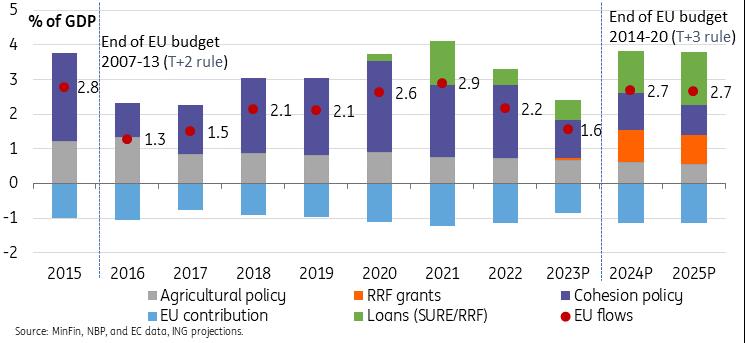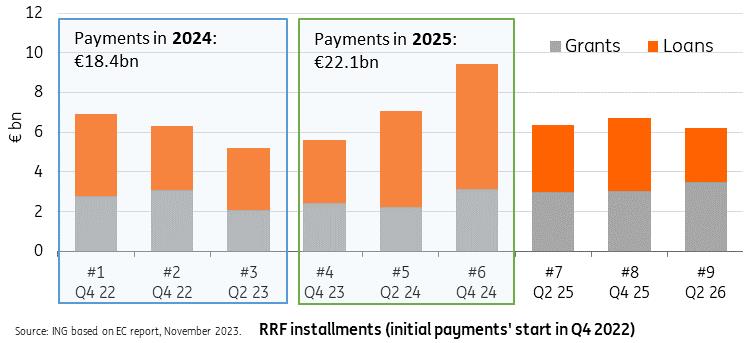(MENAFN- ING)
Last Friday, Ursula von der Leyen, Chairwoman of the European Commission (EC), announced the unlocking of recovery and cohesion funds to Poland of €137 billion. We estimate total net flows this year of up to 2.7% of GDP, up from around 1.6% of GDP in 2023. Full absorption of the funds will be a challenge.
EU grants and preferential loans to Poland
On 23 February, EC Chairwoman Ursula von der Leyen visited Warsaw. At the press conference with PM Donald Tusk, she announced that in the following week, the EC will formally decide to release €137bn of EU funds from cohesion policy (CP) funds and the National Recovery and Resilience Plan (NRRP). Of the announced amount of €137bn, the NRRP (grants and loans) account for almost €60bn, while the remaining €77bn is grant funding from the traditional cohesion policy.
The positive scenario in terms of unblocking EU funds for Poland after the October 2023 general elections is coming true (see our Think article ). Fortunately, the risk of a sudden stop in the inflow of EU funds this year and its implications for growth and public investment has largely been averted.
We see a sizable rise of EU money flowing to Poland. We estimate that the total net inflow of EU funds to Poland (all grants and loans minus the contribution to the EU budget) this year will amount to about 2.7% of GDP versus 1.6% of GDP in 2023. This increase in year-on-year terms partly results from lower-than-expected absorption of cohesion funds in November-December 2023. The combined inflow of CP funds in the last two months of 2023 amounted to merely €1, while in the last two months of 2022 they reached €5. According to the latest official reports of mid-February, there still around €5bn left in the 'old' cohesion policy budget 2014-20. We expect that these funds will still be disbursed this year, given that they were fully contracted.
Projected net flows of EU funds to Poland in 2024-25 (as % of GDP)

Timeline
Following Poland's first payment request from the NRRP from mid-December, the first regular disbursement from this source of €6, including €2 of grants and €4 of preferential loans, is expected in April. Already in very late of December Poland received the first advance payment of €5bn from Re-Power-EU chapter. The country is to submit the second motion for payment of €11 in June, including €5 of grants and €6 of loans. This request will cover the combined second and third tranches from the original NRRP schedule, and is to be disbursed in the autumn.
As for the inflow of the 'new' cohesion policy funds from the 2021-27 EU budget, we expect these funds to 'roll out' gradually during the year and amount to about €4bn in the whole year.
Projected payment schedule from Poland's NRRP in 2024-26 (€bn)

Financial and economic impact
While financial flows related to the use of NRRP will be significant this year, its impact on GDP, particularly investment, will be rather limited. We expect increased investment activity on this account in 2025 and 2026. However, the EU funds should be paid to the central budget and before it is sent to the final beneficiaries it may serve as a liquidity buffer. So effectively they should facilitate meeting high public borrowing needs and managing budget liquidity, thus providing significant support for government T-bonds and the zloty exchange rate this year.
Once EU funds are formally unblocked, the main challenge will remain their effective absorption given the short deadline for the use of NRRP funds. Based on current EU-wide regulations, these funds must be contracted by end-2026. The extension of the deadline cannot be ruled out, however, given that the EC and Member States are all interested in RRF's success story. According to the last week's mid-term evaluation of the RRF, to date €225bn in RRF funds has been disbursed to all Member States, of which €67bn in pre-financing, out of the €723bn instrument, established in February 2021.
Pending NRRP renegotiation
Poland's initial NRRP was submitted to Brussels in May 2021, and therefore many of its milestones need to be updated or revised. The Ministry of Funds and Regional Policy plans a rapid renegotiation of the Plan in the coming months, to be completed before the submission of the second request for payment in June. The negotiations are to involve updating the current milestones (there are currently 55 milestones for policy reforms and 56 for investments), and harmonising the Plan with the current government's programme.
MENAFN27022024000222011065ID1107907142
Author:
Leszek Kasek, Rafal Benecki
*Content Disclaimer:
This publication has been prepared by ING solely for information purposes irrespective of a particular user's means, financial situation or investment objectives. The information does not constitute investment recommendation, and nor is it investment, legal or tax advice or an offer or solicitation to purchase or sell any financial instrument. Read more here: https://think.ing.com/about/disclaimer/
Legal Disclaimer:
MENAFN provides the information “as is” without warranty of any kind. We do not accept any responsibility or liability for the accuracy, content, images, videos, licenses, completeness, legality, or reliability of the information contained in this article. If you have any complaints or copyright issues related to this article, kindly contact the provider above.